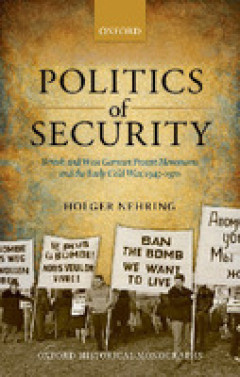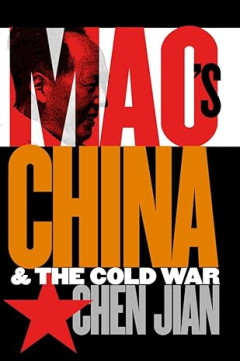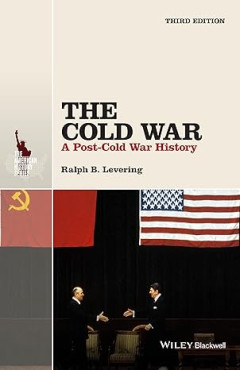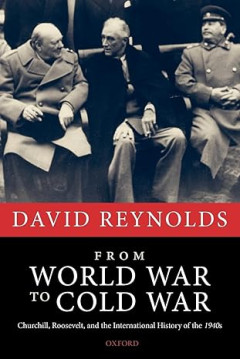Ditapis dengan
E-book Tragedy and Triumph : Early Testimonies of Jewish Survivors of World W…
On 19 June 1942, we arrived at the SS labour camp Mielice (district Krakow). The labour camp was designated for Jews only, and was situated in the grounds of the Heinkel aeroplane factory. At the time of my arrival, the number of Jews working there was approximately 100. About 5,000 Poles and 500 Germans worked in the factory proper. Every day after work, the…
- Edisi
- -
- ISBN/ISSN
- 9781925523881
- Deskripsi Fisik
- 256 hlm
- Judul Seri
- -
- No. Panggil
- 940.53 FRE t

E-book Politics of Security: British and West German Protest Movements and th…
The Politics of Security tells the story of how people experienced the cold war as a war. It is about the impact of the cold war on political cultures. This crucial issue is often forgotten in historical memory. In particular, the book follows British and West German anti-nuclear-weapons activists in their attempts to campaign for and create security after the destruction of the Second World Wa…
- Edisi
- -
- ISBN/ISSN
- 9780199681228
- Deskripsi Fisik
- 342 halaman
- Judul Seri
- -
- No. Panggil
- 940.54 NEH p

E-book Mao's China and the Cold War
This comprehensive study of China's Cold War experience reveals the crucial role Beijing played in shaping the orientation of the global Cold War and the confrontation between the United States and the Soviet Union. The success of China's Communist revolution in 1949 set the stage, Chen says. The Korean War, the Taiwan Strait crises, and the Vietnam War--all of which involved China as a cent…
- Edisi
- -
- ISBN/ISSN
- 9780807849324
- Deskripsi Fisik
- 415 halaman
- Judul Seri
- -
- No. Panggil
- 951 CHE m

E-book The Cold War: A Post-Cold War History, Third Edition
Thoroughly updated in light of new scholarship, including revised sections on President Nixon’s policies in Vietnam and President Reagan’s approach to U.S.-Soviet relations Features six all new "counterparts" sections that juxtapose important historical figures to illustrate the contrasting viewpoints that characterized the Cold War Argues that the success of Western capitalism during th…
- Edisi
- -
- ISBN/ISSN
- 9781118848401
- Deskripsi Fisik
- 298 halaman
- Judul Seri
- -
- No. Panggil
- 940.54 LEV t

E-book From World War to Cold War: Churchill, Roosevelt, and the Internationa…
The 1940s was probably the most dramatic and decisive decade of the 20th century. This volume explores the Second World War and the origins of the Cold War from the vantage point of two of the great powers of that era, Britain and the USA, and of their wartime leaders, Churchill and Roosevelt. It also looks at their chequered relations with Stalin and at how the Grand Alliance crumbled into an …
- Edisi
- -
- ISBN/ISSN
- 9780199237616
- Deskripsi Fisik
- 374 halaman
- Judul Seri
- -
- No. Panggil
- 940.53 REY f
E-book Sport under Unexpected Circumstances : Violence, Discipline, and Leisu…
Sport in camps unsettles both contemporary witnesses and students of history. It seems impossible that human beings would perform anything like sport within the harsh camp reality of repression, hunger, violence, and possibly even murder. Yet, sport in penal and internment camps is a historical reality and studying this history allows for new insights into the reality of i…
- Edisi
- -
- ISBN/ISSN
- 9783666310522
- Deskripsi Fisik
- 285 hlm
- Judul Seri
- -
- No. Panggil
- 940.53 BEE s
E-book Negotiating Nursing
The Second World War was a new type of war; it was a global, mobile and unpredictable war. It was ‘among the most destructive conflicts in human history’, in which over forty-six million people perished, often in the most frightening and inhuman conditions.1 The latter years of the inter-war period witnessed a modernisation of the mili-tary technologies that had been use…
- Edisi
- -
- ISBN/ISSN
- 9781526147257
- Deskripsi Fisik
- 249 hlm
- Judul Seri
- -
- No. Panggil
- 940.53 BRO n
E-book Footprints of War : Militarized Landscapes in Vietnam
In Februruary 1972, Working in the perpetual Drizzle that shrouds the central coast of Vietnam each winter, soldiers from the Army of the Republic of Vietnam (ARVN) produced a photographic inventory of two bases newly acquired from the Americans. Just a few weeks before, some thirty thousand US Army and Marine Corps troops removed themselves with thousands of tons of equipment from Ph�…
- Edisi
- -
- ISBN/ISSN
- 9780295743875
- Deskripsi Fisik
- 282 hlm
- Judul Seri
- -
- No. Panggil
- 940.54 DAV f 002893-eB-0122
E-book Friendship Across the Seas : The US Navy and the Japan Maritime Self-D…
While these displays are all fascinating in their own ways, they do not cover much beyond the defeat of Japan in 1945; no objects related to the JMSDF are on display. “I do think we should display items related to the JMSDF,” said Captain Furush? as he showed us around. “But regrettably, we currently only have displays related to the I…
- Edisi
- -
- ISBN/ISSN
- 9789819929979
- Deskripsi Fisik
- 277 hlm
- Judul Seri
- -
- No. Panggil
- 940.53 AGA f
E-book Japanese Americans at Heart Mountain : Networks, Power, and Everyday Life
On August 8, 1942, 302 people arrived by train at Vocation, Wyoming, to become the first Japanese American residents of what the U.S. government called the Relocation Center at Heart Mountain. In the following weeks and months, they would be joined by some 10,000 of the more than 120,000 people of Japanese descent, two-thirds of them U.S. citizens, incarcerated as “domestic enemy aliens” du…
- Edisi
- -
- ISBN/ISSN
- 9780806192116
- Deskripsi Fisik
- 233 hlm
- Judul Seri
- -
- No. Panggil
- 940.53 KEK j
E-book Okinawa : The Last Battle
On 3 October 1944 American forces in the Pacific Ocean Areas received a directive to seize positions in the Ryukyu Islands (Nansei Shoto). Okinawa is the most important island of the Ryukyu Group, the threshold of the four main islands of Japan. The decision to invade the Ryukyus signalized the readiness of the United States to penetrate the inner ring of Japanese defenses. For the enemy, fail…
- Edisi
- -
- ISBN/ISSN
- -
- Deskripsi Fisik
- 604 hlm
- Judul Seri
- -
- No. Panggil
- 940.53 APL o
E-book War at the Margins : Indigenous Experiences in World War II
y work for the past two decades has dealt with Micronesians’ memories of the Pacific War. Historians have produced libraries of books on that war’s military strategy, on air, naval, and land battles, on the experiences of leaders and ordinary soldiers and sailors—even, more recently, on the meaning of battle sites to Japanese and Americans today. But …
- Edisi
- -
- ISBN/ISSN
- 9780824891800
- Deskripsi Fisik
- 318 hlm
- Judul Seri
- -
- No. Panggil
- 940.53 POY w
E-book Revival After the Great War : Rebuild, Remember, Repair, Reform
018 marked the 100th anniversary of Armistice Day, 11 November 1918. Ironically, “the war that would end all wars” turned out to be a war whose end was long anticipated but “that failed to end” nevertheless.1 For some, the end of the war was already in sight in 1917: the Russian revolution, the American entry into the war, the Brest-Litovsk Treaty (signed in March 1918 between Germany a…
- Edisi
- -
- ISBN/ISSN
- 9789461663542
- Deskripsi Fisik
- 355 hlm
- Judul Seri
- -
- No. Panggil
- 940.53 PUR r
E-book Pearl Harbor : The Story of the Secret War
AT 7:58 A.M. on Sunday, December 7,1941, a radio warning was broadcast to all ships in Pearl Harbor. "Air raid, Pearl Harbor!" the radio screeched. "This is no drill! This is no drill!" Three minutes before, Japanese warplanes had come in over the great naval base at Oahu, launching their first torpedoes and dropping their first bombs. Almost at once a second warning was broadcast by the comma…
- Edisi
- -
- ISBN/ISSN
- 9780939484386
- Deskripsi Fisik
- 441 hlm
- Judul Seri
- -
- No. Panggil
- 940.53 MOR p
E-book You Can Help Your Country : English children's work during the Second …
One of the many exhortations to children to help with the war effort was issued by the Ministry of Information in 1941; its opening paragraph is our opening quotation and its title, which we have borrowed for this book, is ‘You Can Help Your Country’. In the book, we address a neglected topic that is, nevertheless, a part of the history of childhood in twentieth-cent…
- Edisi
- -
- ISBN/ISSN
- 9781787356726
- Deskripsi Fisik
- -
- Judul Seri
- -
- No. Panggil
- 940.53 MAY y
 Karya Umum
Karya Umum  Filsafat
Filsafat  Agama
Agama  Ilmu-ilmu Sosial
Ilmu-ilmu Sosial  Bahasa
Bahasa  Ilmu-ilmu Murni
Ilmu-ilmu Murni  Ilmu-ilmu Terapan
Ilmu-ilmu Terapan  Kesenian, Hiburan, dan Olahraga
Kesenian, Hiburan, dan Olahraga  Kesusastraan
Kesusastraan  Geografi dan Sejarah
Geografi dan Sejarah